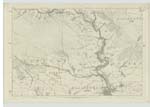OS1/25/42/16
| List of names as written | Various modes of spelling | Authorities for spelling | Situation | Description remarks |
|---|---|---|---|---|
| Supposed Site of the BATTLE OF MONS GRAMPIUS (Continued) | 052 | [continued from page 15] found under another leader, the Romans afterwards did) Their square formed Camp, of which the traces have only of late been obliterated was upon an extensive plain above the new town of Stonehaven and hard by the lately erected Church and Manse of Fetteresso - The Caledonian Camp was pitched at Re-dykes (Re, a King) above the house of Urie upon the face of the hills directly opposite to that of Agricola, at the distance of not more than 2 miles, while he had the sea within somewhat less than a mile to his rear. On an adjoining lower hill called the Kemp Hill (Kemp a fight) were formed not fewer than 5 or 6 Druidical Circles, while all round especially towards the north are scattered a vast number of Cairns or Tumuli of different shapes & dimensions, some of them being of great height & size. At various times also several heads of spears of mixed brass, as almost all those in Scotland ascribed to the Romans are, and other remains of Arms and instruments have been found in the contiguous grounds ....... Every circumstance concurs in pointing out this place as the real scene of the conflict between Agricola and Galgacus, a combination no where else to be found along the whole chain of the Grampian Mountains, at Ardoch, at Dealgin Ross, Strageth, Battledykes, or any other fancied situation - and it is presumed that this much disputed point will be invariably fixed and universally acknowledged to be so - Here the Roman fleet was seen riding at Anchor in the bay of Stonehaven within less than a league of their camp where no enemy could interrupt their mutual intercourse. - Here Galgacus would see the fleet equally well from the hills above, and might justly be made to exclaim imminente nobis classe Romana - And from this place Tacitus might properly say upon Agricola's retreat southward, after the battle "Exercitum in finis Horestium deducit"?- From Essays on Scottish Antiquities by John Stewart Esqr. of Inchbreck Professor of Greek in the Marischal College and University of Aberdeen - Advocate's Library. |
Continued entries/extra info
[Page] 16[Additional note:]
"Maitland, who was the first antiquary, who traced Roman
roads, and Roman Camps, beyond the Tay, was also the first,
who pointed to Urie hill, as the appropriate site of the battle of
Mons Grampius. In his loose conjectures, he was copied by Lord
Buchan, and Roy followed both, who, in giving an account of the
Campaigns of Agricola, is always supposing what cannot be allowed,
and what he cannot prove." Chalmer's in contending for Ardoch as the
scene of the battle - Caledonia Vol [Volume] 1 p [page] 142 note.
Transcribers who have contributed to this page.
Alison James- Moderator, Brenda Pollock
Location information for this page.
Linked mapsheets.




